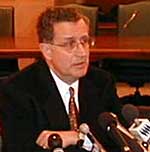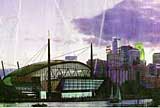Stadium Talk Dominates NFL Official's Visit to Capitol
By William Wilcoxen
January 5, 2001
The National Football League's top executive spent much of Friday at the Capitol talking to lawmakers about the idea of a new stadium for the Vikings. The team doesn't have a specific proposal, but Commissioner Paul Tagliabue's visit signals that the Vikings are gearing up their efforts.
TAGLIABUE AND ABOUT 63,000 OTHER PEOPLE will file into the Hubert Humphrey Metrodome to watch the Vikings face the Saints. With its inflated Teflon roof, the dome has been likened to an oversized marshmallow or a blimp. But, as the building approaches its 19th birthday, Tagliabue offered a reptilian metaphor.
"The reality is simple: domed stadiums such as this are dinosaurs," he said.
In a state Capitol meeting room, Tagliabue explained that around the country stadiums that have tried to accommodate both football and baseball teams are being demolished because they satisfy neither of their principal tenants. He cited Seattle and Houston as two examples of cities that have recently forsaken multi-purpose domed stadiums and replaced them with dual new facilities specifically for football, the other expressly for baseball.
Tagliabue says he discussed this in informal meetings with some of the state's legislative leaders and talked about the possibility of a new Twin Cities football stadium that might serve both the Vikings and the University of Minnesota, whose football program is also not satisfied with the Metrodome.
There were no threats or ultimatums, though. Tagliabue says he did not tell lawmakers such as DFL Senate Majority Leader Roger Moe that the Legislature must act in the current session.
"No, that's really not a judgment I can make. I know there are many, many priorities in every state in the legislative sessions. That's for Senator Moe and the legislative leaders and the governor to make that judgment," Tagliabue told reporters.
Tagliabue says his purpose was to underscore for policymakers that the Vikings need a new facility to keep pace with changes in the NFL, that the investment in a new building would have a long payback, and that a new stadium serving both the Vikings and the university could offer an opportunity to economize. He also said the NFL has a fund it uses to help teams pay for new stadiums, which may cost $350 to $450 million.
By using a non-threatening approach, Tagliabue avoided being rebuffed at the Capitol. Moe says a football stadium is not the most important issue facing the Legislature but he says it is worth talking about.
"It's not going to pre-empt a discussion about tax policy or education funding, but I think in the final analysis these are assets; they're worthy of protection, they're important to a lot of people in this state, and I think they enhance the quality of life, and we ought not just ignore the issue until it becomes a crisis," said Moe.
Moe says it's too early to say what type of legislation, if any, might be proposed at the Capitol this year. Legislative interest in public funding of a stadium has been minimal since constituents swamped the Capitol phone lines in 1998, urging lawmakers to reject financing of a baseball stadium for the Minnesota Twins.
Dick Day of Owatonna, the Senate Republican leader, says the lack of enthusiasm for a stadium bill in the Capitol is an extension of how the public reacts to the idea.
"When we're out talking to, say, 100 people, if you were to bring up a stadium, you get hammered pretty hard, even though I'm sure they're the first ones on Sunday to watch the game," Day said.
Influencing public opinion is also part of the Vikings' stadium strategy. Part of the team Web site is devoted to explaining their reasons for seeking a new building and newspaper advertisements are beginning to carry the same message. The team has enlisted lobbyists, a public relations firm, an architectural firm, and financial consultants. But while a joint facility with the university could be the Vikings key to public financing, the university has not decided if it likes the idea of another shared building.
The U of M's Vice-President of University Services, Eric Kruse, says the university is various stadium options, which include a sharing a new building with the Vikings but also playing in a renovated Metrodome or seeking a new on-campus stadium.
"We want to make sure that if there's going to be this discussion of various scenarios, that we are involved in the very beginning with that discussion at the table, not brought in at the end and told, 'Here's what you need to deal with,' and it's not really what best suits the university program," Kruse told Minnesota Public Radio.
Kruse says the university wants to recapture a collegiate atmosphere at football games, which may or may not coincide with what the Vikings want in a new stadium.
William Wilcoxen covers stadium issues for Minnesota Public Radio. Reach him via e-mail at wwilcoxen@mpr.org.
By William Wilcoxen
January 5, 2001
|
|
RealAudio |
The National Football League's top executive spent much of Friday at the Capitol talking to lawmakers about the idea of a new stadium for the Vikings. The team doesn't have a specific proposal, but Commissioner Paul Tagliabue's visit signals that the Vikings are gearing up their efforts.
| |
|
|
|
||
"The reality is simple: domed stadiums such as this are dinosaurs," he said.
In a state Capitol meeting room, Tagliabue explained that around the country stadiums that have tried to accommodate both football and baseball teams are being demolished because they satisfy neither of their principal tenants. He cited Seattle and Houston as two examples of cities that have recently forsaken multi-purpose domed stadiums and replaced them with dual new facilities specifically for football, the other expressly for baseball.
Tagliabue says he discussed this in informal meetings with some of the state's legislative leaders and talked about the possibility of a new Twin Cities football stadium that might serve both the Vikings and the University of Minnesota, whose football program is also not satisfied with the Metrodome.
There were no threats or ultimatums, though. Tagliabue says he did not tell lawmakers such as DFL Senate Majority Leader Roger Moe that the Legislature must act in the current session.
"No, that's really not a judgment I can make. I know there are many, many priorities in every state in the legislative sessions. That's for Senator Moe and the legislative leaders and the governor to make that judgment," Tagliabue told reporters.
Tagliabue says his purpose was to underscore for policymakers that the Vikings need a new facility to keep pace with changes in the NFL, that the investment in a new building would have a long payback, and that a new stadium serving both the Vikings and the university could offer an opportunity to economize. He also said the NFL has a fund it uses to help teams pay for new stadiums, which may cost $350 to $450 million.
| |
|
|
|
||
"It's not going to pre-empt a discussion about tax policy or education funding, but I think in the final analysis these are assets; they're worthy of protection, they're important to a lot of people in this state, and I think they enhance the quality of life, and we ought not just ignore the issue until it becomes a crisis," said Moe.
Moe says it's too early to say what type of legislation, if any, might be proposed at the Capitol this year. Legislative interest in public funding of a stadium has been minimal since constituents swamped the Capitol phone lines in 1998, urging lawmakers to reject financing of a baseball stadium for the Minnesota Twins.
Dick Day of Owatonna, the Senate Republican leader, says the lack of enthusiasm for a stadium bill in the Capitol is an extension of how the public reacts to the idea.
"When we're out talking to, say, 100 people, if you were to bring up a stadium, you get hammered pretty hard, even though I'm sure they're the first ones on Sunday to watch the game," Day said.
Influencing public opinion is also part of the Vikings' stadium strategy. Part of the team Web site is devoted to explaining their reasons for seeking a new building and newspaper advertisements are beginning to carry the same message. The team has enlisted lobbyists, a public relations firm, an architectural firm, and financial consultants. But while a joint facility with the university could be the Vikings key to public financing, the university has not decided if it likes the idea of another shared building.
The U of M's Vice-President of University Services, Eric Kruse, says the university is various stadium options, which include a sharing a new building with the Vikings but also playing in a renovated Metrodome or seeking a new on-campus stadium.
"We want to make sure that if there's going to be this discussion of various scenarios, that we are involved in the very beginning with that discussion at the table, not brought in at the end and told, 'Here's what you need to deal with,' and it's not really what best suits the university program," Kruse told Minnesota Public Radio.
Kruse says the university wants to recapture a collegiate atmosphere at football games, which may or may not coincide with what the Vikings want in a new stadium.
William Wilcoxen covers stadium issues for Minnesota Public Radio. Reach him via e-mail at wwilcoxen@mpr.org.


